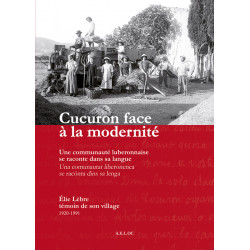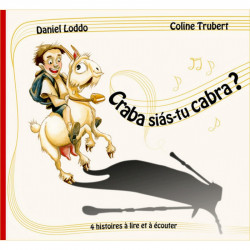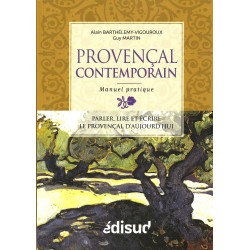Recently added item(s)
No products
Product successfully added to your shopping cart
There are 0 items in your cart. There is 1 item in your cart.
Provence
- New Selection
- Books
- Music
- Videos - DVD
- Miscellaneous
- Revues, Journaux
Links
Cucuron face à la modernité - Une communauté luberonnaise se raconte dans sa langue
L-9782359360103
New
2 Items
Available
15,00 €
Cucuron face à la modernité - Elie LÈBRE, témoin de son village (1920-1991). (Cucuron facing modernity - Elie LÈBRE, witness of his village). Une communauté luberonnaise se raconte dans sa langue (A Luberon community tells its story in its language). Texts by Élie Lèbre and Alain Barthélémy-Vigouroux. Bilingual French/Provençal. Published by AELOc.
Data sheet
| Year | 2021 |
| Language | French + Occitan Provençal |
| Pages | 248 |
| Format | 15 x 21 cm |
| Distributor | A.E.L.OC |
| ISBN | 978-2-35936-010-3 |
| Code Distributeur | 20011 |
| Bonus | Photographies originales d'époque |
More info
Cucuron face à la modernité - Elie LÈBRE, témoin de son village (1920-1991)
Une communauté luberonnaise se raconte dans sa langue - Una comunautat liberonenca se racònta dins sa lenga.
(Cucuron facing modernity - Elie LÈBRE, witness of his village. A Luberon community tells its story in its language)
By recounting in Provençal for a local radio station the story of his life as a farmer in a village in the Luberon, and then compiling a commented collection of 400 proverbs and expressions, Elie Lèbre, who died in 1991, has left an invaluable document for understanding the way in which a rural community of the last century perceived itself in the enormous transformation it underwent, and above all for grasping in its most authentic state the language of the last generation that spoke it as a native tongue. The document is all the more precious because it includes both the text written by the author and the possibility of listening to the recording of his voice on the AELOC website.
Elie Lèbre's work is part of a collective project in which a group of villagers met for fifteen years to allow the younger generation to benefit from the knowledge of the elders about their language. In this group, of which Elie Lèbre was the most reliable reference, 600 other proverbs and expressions were collected and fed the material of the book.
All of the Provençal texts are accompanied by their translation by Alain Barthélemy-Vigouroux, who has also recorded the history of this adventure, as well as a presentation of the main characteristics of Provençal in this area, and a guide to reading the written language. The text is accompanied by a very abundant illustration, provided in large part by a collection of period photos preserved in the Marc Deydier Museum in Cucuron.
Graphic design and layout by Marie-Anne Hauth. Original period photographs.
Texts by Élie Lèbre and Alain Barthélémy-Vigouroux - Bilingual French/Provençal (classic spelling).
Editions AELOc.
Listen here the provençal text recording by the author Elie Lèbre:
Extracts:
Au fieu de l’an, proverbis …
Jorns creissènts, jorns coiènts
jours croissants, jours de froid cuisant
En janvier, jorns creissènts, sovènt freg venènt
en janvier quand les jours croissent, le froid croît aussi
Sant-Clar fa quarantena.
Le temps du 2 janvier dure quarante jours
Se vès au cuou quand lei dènts penchinon
on voit sur les fesses si les dents mâchent beaucoup (si on est gros mangeur)
Quora lei fedas gambadejon e que lei chivaus pisson, aquò marca lo vènt
Quand les brebis gambadent et que les chevaux pissent, cela présage du vent
Aquò es coma de blad ensacat
L’affaire est dans le sac !
Sus son biais de viure ...
"Coma vos l’ai dich, ieu ni mai m’agradava gaire de travalhar la tèrra. S’avieu poscut faire d’estudis, aurieu belèu fach quauquarèn que m’aurié plaisut. Mai es que en fin finala serieu estat pus eros, de fes me pausi la questien. Aurié faugut anar a la vila, belèu se despatriar dins una vila de l’ubac, èstre un deracinat coma n’i a tant a l’ora d’ara . Coma que siegue, s’èri pas restat dins mon vilagi, de segur parlarieu lo provençau encara pus mau que ce que lo parli vuei, e aurieu pas poscut vos contar tot aquò. En totei lei cas se mon paure paire me vesié charrar tot solet davant lo magnetòfòne, me dirié que sieu un bèu colhon de crèire que mei còntes van interessar quauqu’un e bessai aurié pas tot lo tòrt."
Leis escais-noms...
Quand tout le monde connaissait chacun, le surnom supposé qualifier un individu prenait le pas sur son nom de baptème. Ici, Elie Lebre évoque les sobriquets des femmes. Nous verrons bientôt ceux dont les hommes étaient affublés.
I avié pereu de fremas qu’avien d’escais-noms : la Rablada (la râblée), la Tambòta ( la tambote), la Tripalhona (la tripaillone), la Titè (la poupée), la Chiga (la chigue), la Cicòri ( la chicorèe), la Monja (la nonne) qu’èra estada un pauc au covènt, la Desnarrada ( la sans nez), percequ’avié quasi gis de nas ; la Cantarèla (la chanterelle, chanteuse) que cantava totjorn dins lei velhadas.
Reviews
No customer comments for the moment.
 English
English Français
Français Occitan
Occitan














